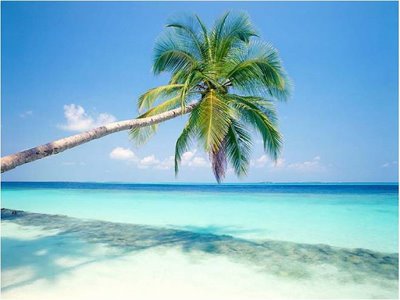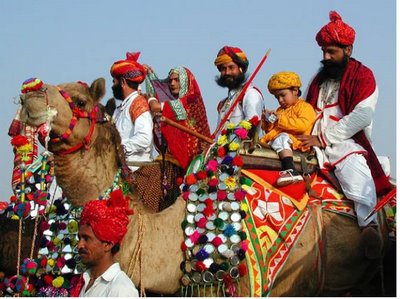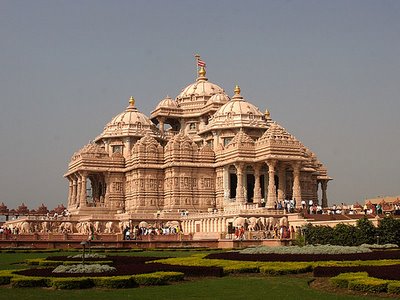Time for ...India:)
Over 1 billion people lives in India. A lot of. And as I can read the society is very divided too:(((.

The Republic of India is a country that occupies a greater part of South Asia. It has a coastline of over seven thousand kilometres, borders Pakistan to the west, the People's Republic of China, Nepal, and Bhutan to the north, and Bangladesh and Myanmar to the east. In the Indian Ocean, it is adjacent to three island nations – the Maldives to the southwest, Sri Lanka to the south, and Indonesia to the southeast. India also claims a border with Afghanistan to the northwest.

India's Maldives - on the picture above:) A real paradise - you have to admit it:)
The name India /'ɪndiə/ is derived from the Old Persian version of Sindhu, the historic local appellation for the River Indus (see Origin of India's name). The Constitution of India and common usage also recognise Bharat, as an official name of equal status. A third name, Hindustan has been used since the twelfth century, though its contemporary use is unevenly applied due to domestic disputes by some over its representation as a national signifier.
India is the fourth largest economy in the world in terms of purchasing power parity (PPP) and the tenth largest in nominal (exchange-rate) terms. With a population of over one billion, it is the second most populous country in the world and the world's largest liberal democracy. India is also seventh largest country by geographical area.
As home to one of the four major ancient civilisations and a center of important trade routes, India has long played a significant role in human history. Famous for its rich religious traditions, four of the major world religions–Hinduism, Buddhism, Jainism, and Sikhism–all have their origins in India.
A former colony of the British Empire, India gained independence in 1947 as a unified state. The country suffered from stagnation for many decades and was relegated to the status of a leader of the Third World. Since the 1980s, however, India has begun liberalizing its economy and opening its doors to free trade. Today, India's influence, especially in the political and economic spheres, has grown significantly and it is now considered a major power.
History
Stone Age rock shelters with paintings at Bhimbetka in Madhya Pradesh are the earliest known traces of human life in present-day India. The first known permanent settlements appeared over 9,000 years ago, and gradually developed into the Indus Valley Civilisation, which began around 3300 BCE and peaked between 2600 BCE and 1900 BCE. It was followed by the Vedic Civilisation. This civilisation was preceded by the Indus valley civilisation in northern parts of the present day India and Pakistan.From around 550 BCE, many independent kingdoms came into being.
In the north, the Maurya dynasty, which included Ashoka, contributed greatly to India's cultural landscape. From 180 BCE, a series of invasions from Central Asia followed. This led to the establishment of the Indo-Greek, Indo-Scythian and Indo-Parthian kingdoms in the northern Indian Subcontinent, and finally the Kushan Empire. From the third century BCE, the Gupta dynasty oversaw the period referred to as ancient India's "Golden Age". In the south, several dynasties, including the Chalukyas, Rashtrakutas, Pallavas and Pandyas prevailed during different periods. Science, engineering, art, literature, mathematics, astronomy, religion and philosophy flourished under the patronage of these kings.
Following the Islamic invasions from Central Asia and Persia in the seventh to the twelfth centuries, much of north and central India came under the rule of the Delhi Sultanate, and later the Mughal dynasty, who gradually expanded their reign to much of the Indian subcontinent. Nevertheless, several indigenous kingdoms flourished, especially in the relatively sheltered south, like the Vijayanagara Empire. During mid-second millennium, several European countries, including Portugal, Netherlands, France and the United Kingdom, who initially wanted to trade with India, took advantage of the fractured kingdoms fighting each other, to establish colonies in the country. In 1857, an insurrection, known locally as the First War of Indian Independence against the British East India Company failed. This resulted in much of India coming under the direct administrative control of the crown of the British Empire. In the early twentieth century, the prolonged, non-violent struggle for independence was led by Mahatma Gandhi, widely regarded as the "Father of the Nation." The struggle culminated on 15 August 1947 when India gained full independence from British rule, and became a republic on 26 January 1950.
As a multi-ethnic and multi-religious nation, India has had some sectarian violence and insurgencies in various parts of the country, but has stayed together as a vibrant democracy. It has unresolved border disputes with China, which escalated into the brief Sino-Indian War in 1962; and with Pakistan, which resulted in wars in 1947, 1965, 1971 and in 1999 in Kargil. India is a founding member of the Non-Aligned Movement and the United Nations. In 1974, India conducted an underground nuclear test, making it an unofficial member of the "nuclear club". This was followed by a series of five more tests in 1998. Significant economic reforms beginning in 1991 have transformed India into one of the fastest-growing economies in the world, and added to its global and regional clout.
States and union territories
India is divided into twenty-eight states (which are further subdivided into districts) and seven union territories. All states and the union territories of Delhi and Pondicherry have elected governments. The remaining five union territories have centrally-appointed administrators.
States:
Union Territories:
- Andaman and Nicobar Islands
- Chandigarh
- Dadra and Nagar Haveli
- Daman and Diu
- Lakshadweep
- Pondicherry
- National Capital Territory of Delhi
 On the picture above you can see traditional garments from people
On the picture above you can see traditional garments from people
from Rajhastan state (find on the map above)
Geography
India is largely on the Indian subcontinent situated on the Indian Plate, the northerly portion of the Indo-Australian Plate, in southern Asia. India's northern and northeastern states are partially situated in the Himalayan Mountain Range. The rest of northern, central and eastern India consists of the fertile Indo-Gangetic plain. In the west, bordering southeast Pakistan, lies the Thar Desert. The southern Indian Peninsula is almost entirely composed of the Deccan plateau, which is flanked by two hilly coastal ranges, the Western Ghats and Eastern Ghats.
India is home to several major rivers, including the Ganga, Brahmaputra, Yamuna, Godavari, Kaveri, and Krishna. India has three archipelagos – Lakshadweep off the southwest coast, the Andaman and Nicobar Islands volcanic island chain to the southeast, and the Sunderbans in the Gangetic Delta in West Bengal State. The Indian climate varies from tropical in the south to more temperate in the north. The Himalayan parts of India have a tundra climate. India gets most of its rains through the monsoons.
Demographics
India is the second-most populous country in the world with an estimated 1.19 billion people in 2006. The main determinants of social and political organisation within the highly diverse population are language, religion and caste. India's largest metropolitan agglomerations are Mumbai (formerly Bombay), Delhi, Kolkata (formerly Calcutta) and Chennai (formerly Madras). India's literacy rate is 64.8% overall, 53.7% for females and 75.3% of males. The gender ratio is 933 females per 1000 males. The Work Participation Rate (WPR; the percentage of workers to total population) is 39.1%, with male WPR at 51.7% and female WPR at 25.6%. India's median age is 24.66, and the population growth rate is 22.32 births per 1,000.
Although 80.5% of the people are Hindus, India is also home to the third-largest population of Muslims in the world (13.4%; see Islam in India), after Indonesia and Pakistan. Other religious groups include Christians (2.3%), Sikhs (1.84%), Buddhists (0.76%), Jains (0.40%), Jews, Zoroastrians, Ahmadi Muslims, and Bahá'ís. India is home to two major linguistic families: Indo-Aryan (spoken by about 74% of the population) and Dravidian (spoken by about 24%) with a number of other languages from the Austro-Asiatic and Tibeto-Burman linguistic families. The constitution recognises 23 official languages. Hindi and English are used by the Central Government for official purposes. Two classical languages native to the land are Sanskrit and Tamil. The number of mother tongues in India is as high as 1,652.
Culture
India has a rich and unique cultural heritage, and has managed to preserve its established traditions throughout history whilst absorbing customs, traditions and ideas from both invaders and immigrants. Many cultural practices, languages, customs and monuments are examples of this co-mingling over centuries. Famous monuments, such as the Taj Mahal and other examples of Islamic-inspired architecture have been inherited from the Mughal dynasty. These are the result of a syncretic tradition that combined elements from all parts of the country. Indian society is largely pluralist, multilingual and multicultural.
 On the picture above-Taj Mahal - the monument located in Agra in India, constructed between 1631 and 1654 by a workforce of more than twenty thousand. The Mughal Emperor Shah Jahan commissioned its construction as a mausoleum for his favorite wife, Arjumand Banu Begum, who was known as Mumtaz Mahal.
On the picture above-Taj Mahal - the monument located in Agra in India, constructed between 1631 and 1654 by a workforce of more than twenty thousand. The Mughal Emperor Shah Jahan commissioned its construction as a mausoleum for his favorite wife, Arjumand Banu Begum, who was known as Mumtaz Mahal.
The Taj (as it is often called) is generally considered the finest example of Mughal architecture, a style that combines elements of Hindu and Persian architectures. The Taj has achieved special note because of the romance of its inspiration. While the white domed marble mausoleum is the most familiar part of the monument, the Taj is actually a complex of elements.
Indian music is represented in a wide variety of forms. The two main forms of classical music are Carnatic from South India, and Hindustani from North India. Popular forms of music also prevail, the most notable being Filmi music. In addition to this are the diverse traditions of folk music from different parts of the country. Many classical dance forms exist, including the Bharatanatyam, Kathakali, Kathak and Manipuri. They often have a narrative form and are usually infused with devotional and spiritual elements. The earliest literary traditions in India were mostly oral, and were later transcribed. Most of these are represented by sacred works like the Vedas and the epics of the Mahabharatha and Ramayana. Sangam literature from Tamil Nadu represents some of India's oldest traditions. There have been many notable modern Indian writers, both in Indian languages and in English. India's only Nobel laureate in literature was the Bengali writer Rabindranath Tagore. India produces the world's largest number of films every year. The most recognisable face is that of cinema production based in Mumbai, which produces mainly commercial Hindi films, often referred to as "Bollywood". There are also strong cinema industries based on the Kannada, Malayalam, Tamil, Bhojpuri and Telugu languages.
Religious practices of various faiths are an integral part of everyday life in society.
 On the picture above -Swaminarayan Akshardham is a Hindu temple complex in Delhi, India. Inaugurated in November 2005 by the President of India, Abdul Kalam, the Prime Minisiter, Manmohan Singh, and the leader of the organisation responsible for the creation of Akshardham, Pramukh Swami Maharaj, this complex has already attracted tens of thousands of visitors from all over the globe.
On the picture above -Swaminarayan Akshardham is a Hindu temple complex in Delhi, India. Inaugurated in November 2005 by the President of India, Abdul Kalam, the Prime Minisiter, Manmohan Singh, and the leader of the organisation responsible for the creation of Akshardham, Pramukh Swami Maharaj, this complex has already attracted tens of thousands of visitors from all over the globe.
Education is highly regarded by members of every socio-economic stratum. Traditional Indian family values are highly respected, and considered sacred, although urban families have grown to prefer a nuclear family system, owing to the socio-economic constraints imposed by the traditional joint family system. Religion in India is a very public affair, with many practices imbued with pomp and vitality accompanying their underlying spiritual qualities. A melting pot of many religions, India has a rich diversity of festivals, many of which are celebrated irrespective of caste and creed. The most widely known and popular celebrations include the Hindu festivals of Diwali, Holi, and Dussehra, and the Muslim celebration of Eid.
The cuisine of India is extremely diverse, as ingredients, spices and cooking methods vary from region to region. Rice and wheat are the staple foods in the country. The country is notable for its wide variety of vegetarian and non vegetarian cuisine. Spicy food and sweets are popular in India. Traditional dress in India greatly varies across the regions in its colours and styles, and depend on various factors, including climate. Popular styles of dress include the traditional sari for women and the traditional dhoti for men.
Sports and games
India's national sport is field hockey, although cricket is now the de facto national game. In some states, particularly in the northeast, football (soccer) is the most popular sport and is widely watched. India is also represented in chess, with international-level players including Viswanathan Anand who was FIDE World Champion. India has also seen some success in tennis with several players securing individual titles and Grand Slam doubles wins.
 India cricket fans from Mumbai on the picture above:)
India cricket fans from Mumbai on the picture above:)
Traditional indigenous sports include Polo, Kabaddi and Gilli-danda, which are played in most parts of the country. Chess, badminton and carom are also said to have originated in India. Snooker and badminton have seen Indians achieve some international success.
Be prepared for the most SHOCKING India's pictures ever- soon only on my blog!!!
Dancing, dangerous snakes jumping out of Fakirs baskets and jugs!!!
This is REAL India:)
Read me soon!!!:)


3 Comments:
I am Indian and I must say you have an excellent indepth description of past and present of my country. Thanks.
chintan, no way! this is all copied from wikipedia.
Yes - this is copied from wikipedia because - be serious people - what can I know about India?!? Reading Wikipedia, however, I can learn a lot of new things:) + reading it in English, specially.
Personally I think India is a very interesting country.
I will tell you something - Nepal is a neighbour of India and Nepal is between India and China - two big countries. As far as I know India never attacked Tybet. That's why I like India. Because Hindu people are MOSTLY peaceful- it seems to me:)
Pecaeful and friendly:)
God bless all Hindu people.
:)
Post a Comment
<< Home